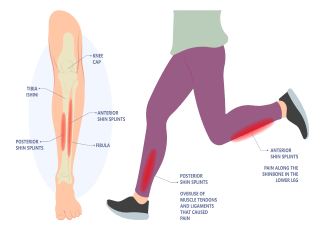How to Fix Shin Splints
If you feel a sharp pain on the front or side of your shin bone that’s worse when you run, you may have shin splints. Medial tibial stress syndrome is the medical term referring to several possible injuries in the lower leg, including muscle and tendon damage, micro fractures, or even nerve problems. Soft tissue injuries are the most likely culprit, and while it can feel very serious, it’s usually a minor injury that appears when some new activity, intensity, footwear, or new running surface is introduced.
With rest, self-care, and reduced impact, most people make a full recovery within two to six weeks and return to activity without long-term complications. If you have shin splints, the tips and corrective exercises in this guide will help to accelerate your healing journey.
Healing Tips
Don’t push through pain, but don’t stop moving.
Your goal is to find a way to stay active without further aggravating the injury. Movement, and even a little stress is needed for soft tissues to heal strong, so slow down. Since new activities, intensity, shoes, or surfaces often start the problem, try reverting back to your pre-injury habits—at least for now. Try the treadmill instead of the road, swap your new shoes for your old ones, and slow down as you heal.
Pain relief tricks don’t heal.
Ice, compression, and painkillers will reduce inflammation and circulation to the affected area. This reduces pain but does not speed up healing. In the worst cases, it gives you a free pass to push again into the damaged area. Use pain killers only as needed to sleep or find comfort during the day, do not use them to heal.
Avoid aggressive massage.
Using a Theragun, aggressive massage with elbows, and deep stretching multiple times a day is not the best course of action. Damaged muscles and inflamed tendons do not respond well to this type of treatment.
Corrective Exercises
While they are healing, the muscles and tendons in your shin area need mobilization and gentle load to stimulate strong scar tissue formation. During the first couple of weeks, the safest way to accomplish gentle load is through isometric holds. These practices are designed to gently load the muscles of your lower leg, specifically your anterior tibialis, posterior tibialis, soleus, and gastrocnemius muscles.
Aim to practice them a couple of times a day and remember to stick to a moderate intensity – no more than a five out of ten perceived intensity. Slow down now to speed up soon. With care, you’ll be back to the activities you love, pain-free, faster than you think.
Dorsi Lunge
- Stand in front of a chair or stool, feet hip-width apart
- Hinge forward, place your hands on the chair for balance
- Lunge your right leg back about two feet behind you, and from here find your balance by kicking back and straightening your leg completely, heel lifted
- Optional: lift your arms like an airplane, gaze forward, and again, kick back into your heel
- Feel both a stretch and a gentle loading in the back of your leg
- If your knee feels wobbly or unstable, place your fingertips or hands back on the chair
- Hold for 20 seconds, breathing in and out through your nose
- Release, shake it out, then swap sides
Plantar Lunge
- Stand in front of your chair or stool, place your hands down
- Step your right leg back, but this time point your toes so you’re on the top of your foot
- Take a smaller stance if you need to
- Optional: lift your hands off the stool to rise, you might feel a little bit wobbly here
- As soon as you can, straighten your back leg all the way, press down into the top of your back foot, lengthen through your spine
- Gaze forward, breathe through your nose, and hold for 20 seconds
- Place your hands down, step back, shake it out
- Switch legs and repeat
Safety Disclaimer
This guide is for educational purposes only. If your shin pain is persistent or severe, it could be a sign of a more serious injury. Rest and see a doctor.
Want to Learn More?
- Science of Stretching 5-Day Program (on demand)
- YOGABODY YouTube Channel (free to subscribe)
- The Lucas Rockwood Show (podcast)
 Article by
Article by 





